THE MAN FROM UTOPIA: RECITATIVES
On "The man from Utopia" (1983) Zappa experimented with improvised recitatives with a melody directly derived from a spoken text, unrelated to scales. Two such live improvisations were included. Steve Vai was asked to score them out to make a guitar overdub along Zappa's melody possible. At first this looked like a novelty specific for this album, but with later live issues it turned out that he did this on a much larger scale during his 1980-82 tours. So "The torture never stops" version from the 1980 tour is included in this section as well.
1. Cocaine decisions
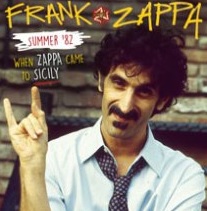 "Cocaine decisions" is Zappa's most direct song about the use of drugs. It has a rapidly pulsing bass line all through, just
playing the subsequent pedal notes. It's characteristic for this particular song, but not at all for his music in general.
The song knows two large themes, following a modulation scheme. The example below contains the following:
"Cocaine decisions" is Zappa's most direct song about the use of drugs. It has a rapidly pulsing bass line all through, just
playing the subsequent pedal notes. It's characteristic for this particular song, but not at all for his music in general.
The song knows two large themes, following a modulation scheme. The example below contains the following:
- bars 1-5: main motifs from the first theme, played instrumentally. It's in C with a I-II alternation. The bass is only switching between
pedal notes, but the keyboard is playing around it with chords.
- bars 6-11, second theme, phrase one. Here Zappa is using the set C#-D-E#-F#-G#-A-B, next to "Transylvania boogie"
a second instance of him using a gypsy type of scale. In the example the E# from the scale is notated as an F.
- bars 12-16, phrase two in D Lydian.
Not included in the example is phrase three of the second theme in G Mixolydian.
Cocaine decisions, 1:38-2:07 (midi file)
Cocaine decisions, 1:38-2:07 (transcription).
At the time of its release the album cover got just as much attention as the music. It's a drawing by Tanino Liberatore.
What it was about became much clearer with the release of "YCDTOSA Vol. IV". There you've got a live version of "Cocaine decisions"
including parts from the 1982 concert at Palermo, Sicily, 1982. Zappa briefly describes the riot that ensued when people from outside tried
to enter the concert area.
At another open air concert in Italy, the band had to play with mosquitos from a nearby swamp hindering them.
So you get Zappa pictured as an enraged Hulk figure hitting at flies. Below you can find small outtake from the album front cover with road signs to some
of the cities from the Italian leg of the 1982 tour. To the right and below screenshots from the documentary "Summer 1982, when Zappa came to Sicily".
It's about the Zappa family visiting Sicily in 2013. They are hosted by Massimo Bassoli, who's driving them around. Several people are recollecting what went wrong
at the concert. It also gave them the opportunity to visit Italian relatives from Frank Zappa's father's side.
This documentary was broadcast in 2013 on Italian TV and more recently made available to the public as a Blu-ray MVD.
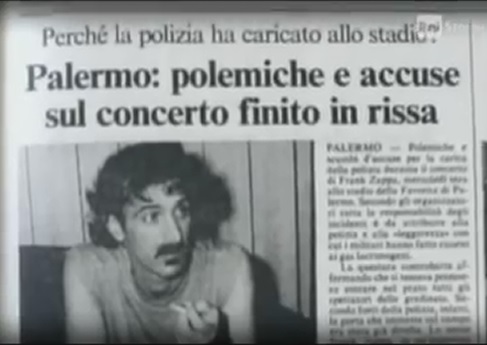
Comment in an Italian newspaper saying:
"Because the police charged at the stadium. Palermo: contraversies and accusations about the concert ended in a fight."
2. SEX
"SEX" is an easy going but solid rock song. It has three themes, the third with Zappa citing from The Sniffer. The example below is the opening with the instrumental
opening and beginning of theme one.
SEX, opening (midi file).
SEX, opening (transcription).
- 0:00: Bars 1-4 are the instrumental intro, a I-IV alternation in A Mixolydian.
- 0:13: "What's the thing that is talkin' 'bout everywhere ..." The first theme, made up of a repeating two-bar motif.
The harmonies are a parallel movement of two major chords, C and AbM7, not attributable to one particular scale.
The grammar gets a bit twisted to let the lyrics fit in better with the rhythm. "That they are talking about" becomes "that is talkin' 'bout",
because of the speed it has to be pronounced with. In this case it's the opposite of speech-influenced melodies.
- 1:05: "Some girls try it 'n' go on a diet ..." Theme two using the C#m, B and A-chords in C# minor.
- 1:31: "The bigger the cushion, the better the pushin'". Theme three with a I-II alternation in D Mixolydian.
- 1:49: Theme one.
- 2:41: Theme two.
- 3:08: Theme three.
- 3:25: Theme three once more as outro.
- 3:43: End.
3. Tink walks amok
"Tink walks amok", one of the three instrumentals from the album, deals with varying bass motifs. The example below is the opening with the basic
motif in 11/16, interrupted by one bar in 4/4. The 11/16 bars have a subdivision doing 4+4+3. The notes of the
first 4/16 block can take
a fourth or fifth as interval jump. The second 4/16 block contains a third consistently. The third figure has a second followed
by a third. The song has two bass lines that complete each other. One is a bass guitar,
slapping the accentuated notes and picking the others. The other
is a double-channeled synthesizer bass.
Tink walks amok, opening (midi file)
Tink walks amok, opening (transcription).
The first half of "Tink walks amok" has its basis in E Mixolydian, but bars can also be in the related keys of
E and E Lydian, that differ by one or two sharps. Bars 8-9 are clearly taking a different direction. When you take
the opening bass note as key note the scale would be G in these two bars. Half-way this song you get
to a section where figures are getting repeated:
- 1:38-2:17: B minor/Dorian (the G/G# is avoided).
This avoidance of the 7th note is also addressed to in the Burnt weeny sandwich section. At 2:13-2:17 you've got
a short melodic line that effectuates a modulation (G-A-C-D-E-D-C-D-E). It returns at 2:33, 2:46 and 3:05.
- 2:17-2:36: C pedal.
- 2:36-2:49: melody in C Mixolydian.
- 2:49-2:57: B pedal.
- 2:57-3:08: Ab pedal.
Coda:
- 3:08-3:33: melody upon B using solely B-C#-F#-G# ("quatratonic").
- 3:33-3:38: the piece ends with an evasive melodic line, eventually landing on just the E.
4. The radio is broken
A studio recorded recitative is "The radio is broken", that is partially improvised,
partially prescribed. The way the vocalists interact works out well. Its general structure goes as:
0:00-1:01 Block I with free bass lines.
1:01-1:25 Intermezzo figure I.
1:25-2:22 Block II with keyboard/bass riff.
2:22-2:46 Intermezzo figure I.
2:46-3:49 Block III with bass/synthesizer riff.
3:49-4:01 Intermezzo figure II.
4:01-5:29 Block IV with free bass lines as in block I.
5:29-5:54 Intermezzo figure I and coda.
The radio is broken, 1:07-1:34 (midi file).
The radio is broken, 1:07-1:34 (transcription).
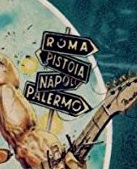 The example contains the 1st intermezzo figure - a fast guitar riff in 16/32 subdivided as 5+5+6 - and
the beginning of block II. The material is partly diatonic, partly chromatic. Transcribing forces you to listen to the details and in this case it appeared
I always underestimated this piece.
The example contains the 1st intermezzo figure - a fast guitar riff in 16/32 subdivided as 5+5+6 - and
the beginning of block II. The material is partly diatonic, partly chromatic. Transcribing forces you to listen to the details and in this case it appeared
I always underestimated this piece.
The speech influence was transferred to the other songs with lyrics by stressing Zappa's voice. In combination
with the flatness of some of the themes, this gave the album an air of coldness. Especially "Stick together",
with a slow and simple reggae tune repeated for three minutes, worked estranging for myself.
This effect was partially undone in the CD remix, where the other instruments were given more space. In "Stick together"
the vocal parts by Ike Willis and Ray White were brought to the foreground, giving it more colour. Together with the three good instrumentals,
"The man from Utopia" has become a bit defrosted.
5. We are not alone
"We are not alone" is the second instrumental you can find on "The man from Utopia", featuring a sax for playing the lead melody. Its construction goes as follows:
- 0:00 Theme I, phrase 1, played twice.
- 0:10 Theme I, phrase 2.
- 0:20 Theme I, phrase 1, played twice.
This is where the transcription from below starts. Bars 1-2 represent phrase 1, repeated in bars 3-4. It's a progression in F# minor (Aeolian)
with as chord progression I-VII-III.
- 0:30 Theme I, phrase 2.
Zappa has modulated to C. A descending line is followed by the sax and bass: C-B-A-G. The chords that are used on top of these four notes
are respectively I-IV-VI-VI. The total sounding harmony, thus created, can consist of larger chords. For instance in bar 6, the bass and the descant chord
are in combination forming the VII 9th chord. Phrase 2 ends with another modulation to E in bar 8. This bar, with a semi-improvised guitar line, serves as
the coda for theme I.
- 0:39 Theme II, phrase 1.
Theme II is not specifically following one particular scale, but switches between chords from different keys. Only nominally the song continues in E, with notes
altering during beats 3 and 4 (more like E Dorian). The A# in bar 9 is an incidental chromatic note by the bass player. It can be better described
as a chord progression unrelated to scales. Bars 9-10 use B-Em-G-F#m-B-Em over mostly an E pedal by the bass. The note example below ends here, after which
bars 9-10 get repeated likewise.
- 0:49 Theme II, phrase 2.
A variation upon phrase 1. The chords progression now has become Db-D-E.
- 0:58 Theme II, phrases 1-2 get repeated.
- 1:17 Theme I, phrases 1-2 get played twice as above.
- 1:56 Theme II, phrases 1-2 get played twice as above.
- 2:23 Theme I, phrases 1-2, transposed up a minor second.
- 2:52 Theme I, phrases 1-2 repeated for the final time, ending with a little coda. The coda is ultimately using the progression Bbm-Gb-Bb.
We are not alone, 0:20 till 0:44 (midi file)
We are not alone, 0:20 till 0:44 (transcription).
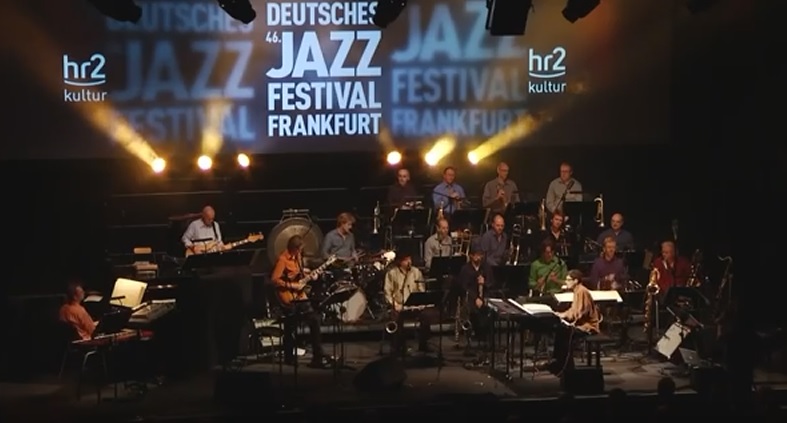
The hr-Bigband playing "We are not alone" (Deutsches Jazzfestival Frankfurt 2015).
"We are not alone" is largely written in 4/4. In my example only bar 8 interrupts the pattern by enlarging a bar to 5/4. Notable is the high
degree of syncopism during this song. The following is happening during bars 1-6:
- The lead melody from theme one gets before beat twice in bars 1 and 3.
- The rhythm guitar (staff 2) can be off-beat, the reggae type of playing, as well as on beat.
- The marimba and guitars (staves 3-4) are playing in a semi-improvised manner along the chord pattern, also frequently forming syncopic figures.
- The bass is mostly an on beat pedal note. On beat 2 the bass player mostly breaks this pattern by playing off beat as well.
Beats 3-5 from bar 8 form a syncopic figure for everybody, with three beats getting subdivided into four times 3/16. Another such example
from my study is "Let's move to Cleveland", bar 10.
6 The dangerous kitchen
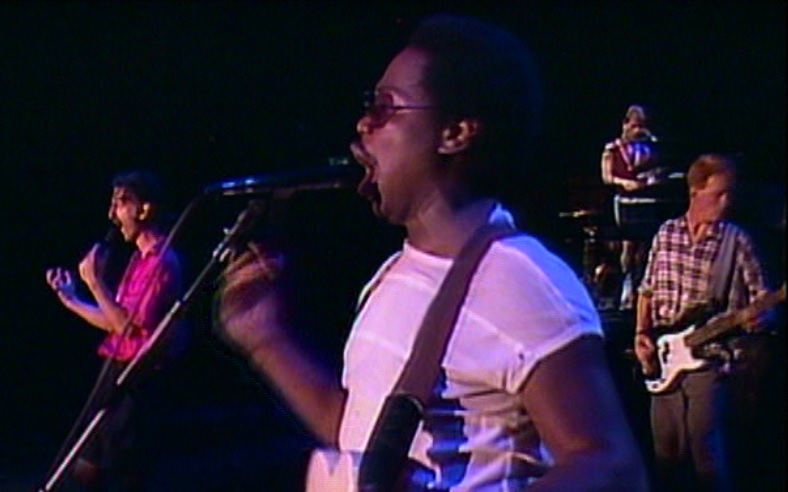 "The dangerous kitchen" is the one of the two live recitatives, that Steve Vai transcribed. Both used to be available
at Barfko Swill. Two samples from "The jazz discharge party hats" are included below at track 9. It got used for letting Steve
Vai double Zappa's recitative on guitar. As it comes to the lyrics this piece can be seen as literature.
On the "Does humor belong in music" DVD there's a 1984 performance of "The dangerous kitchen" with the same lyrics.
So it wasn't improvised, at least not anymore.
"The dangerous kitchen" is the one of the two live recitatives, that Steve Vai transcribed. Both used to be available
at Barfko Swill. Two samples from "The jazz discharge party hats" are included below at track 9. It got used for letting Steve
Vai double Zappa's recitative on guitar. As it comes to the lyrics this piece can be seen as literature.
On the "Does humor belong in music" DVD there's a 1984 performance of "The dangerous kitchen" with the same lyrics.
So it wasn't improvised, at least not anymore.
The dangerous kitchen, 2:11-2:18 (midi file).
The dangerous kitchen, 2:11-2:18 (transcription).
Some of the musical phrases were prescribed too as "who the fuck wants
to clean it?" and the ending line "... at my house tonight" (image to the right with the band singing it).
Below is a sample from the score by Steve Vai I could find on the net, the only bars in my possession. The example above is a fragment transcribed by myself
with all parts included (except the drums), as played on "The man from Utopia". Because it already exists as official score, there's no point in doing a larger
example. Quite obviously this material is atonal, using varying meters and irregular rhythmic groupings. The speach influence upon the rhythm is direct, but not always
present. The sentence "you must walk very careful", for instance is musical.
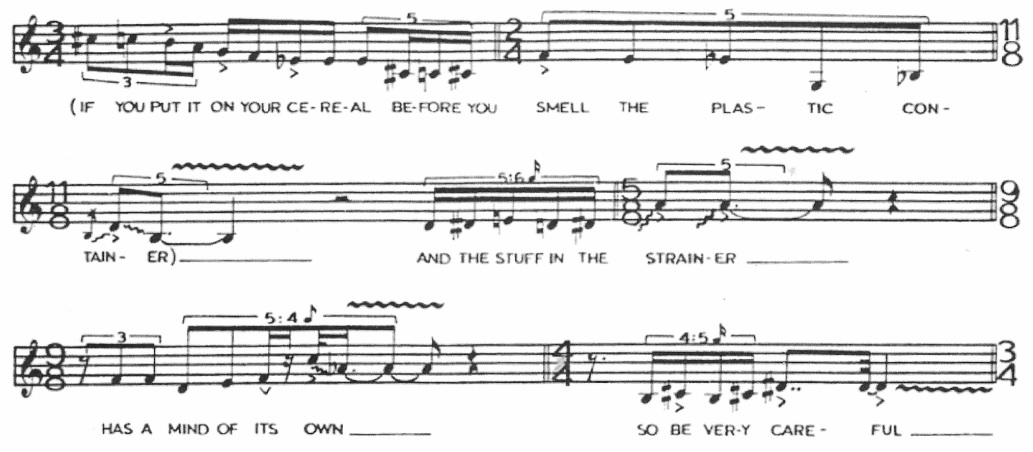
Sample from the "The dangerous kitchen" transcription by Steve Vai.
7. The man from Utopia meets Mary Lou
"The man from Utopia meets Mary Lou" is a medley of two fifties songs from Zappa's record collection. It's a cover of songs written by D. Woods and Obie Jessie. "YCDTOSA Vol. IV" ends with five of such songs. It includes these two, played live, now listed as individual tracks.
8. Stick together
"Stick together" is a slow reggae song. The song has only one chord progression for both the verse and the chorus.
Only the rhythm varies a bit. As already mentioned above, this piece greatly benefited from the remix Zappa did for the CD version. The background vocalists
are now placed in the foreground. Because of the rather simple structure of this song it really needed that.
Stick together (1983), 0:04-0:20 (midi file)
Stick together (1983), 0:04-0:20 (transcription).
Above are the instrumental opening bars from this song. It's gentle reggae with its typical ingredients:
- The accent on the third beat by the bass with
the downbeat sometimes limited to a bass drum beat only.
- The rhythm guitar chords on the second and fourth beat.
A couple of percussion elements are included, that have a pitch to some degree (for that reason they are included in the transcription).
Softly in the background you can hear a keyboard playing (staff 2).
All through this piece you can hear an I-IV alternation in A Mixolydian. The G natural from this scale fails during the opening, to first appear
in one of the accompanying vocal lines at 0:43 minutes.
Stick together (1984), 0:24-0:38 (midi file).
Stick together (1984), 0:24-0:38 (transcription).
The 1984 live version on "YCDTOSA Vol. IV" goes much faster, 2:04 minutes compared to the 3:18 minutes on the album. It gets some more energy this way,
just because of the tempo change. The reggae rhythm now gets handled in a manner that at that time got called ska, with off-beat rhythm guitar chords.
The first two bars are the end of the verse, bars 3-6 contain the chorus. The pitch has been transposed a minor second up to Bb Lydian. During the chorus the band sings together,
forming harmonies. During the chorus Zappa and the band members sing their own part.
9. The jazz discharge party hats
Beneath are the bars from "The jazz discharge party hats", that have been included as an example in the Frank Zappa Guitar book.
As it comes to reciting texts, "The dangerous kitchen" and this song can be called an achievement. At no point there's any hesitance
about what notes to pick and nowhere Zappa stumbles over his words.
The jazz discharge party hats, 3:11 till 3:18 (midi file)
The jazz discharge party hats, 3:11 till 3:18, melody (notes).
Zappa did such improvisations mostly during his
1980 and 1981 tours. Three other examples can be found on the ZFT release "Buffalo". Included in this double CD are
an early "Drowning witch" version, with only the words written, a spoken section of "The torture never stops" (below) and a nine
minutes lecture, called "The "real world" thematic extrapolations".
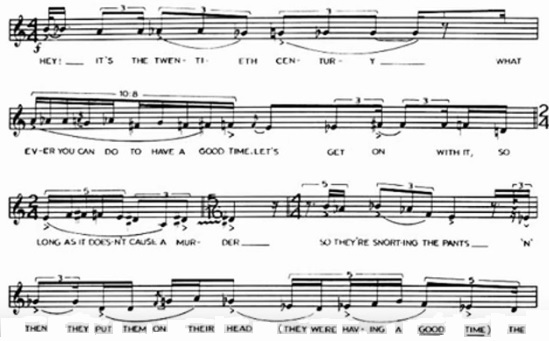
Sample from the "The jazz discharge party hats" transcription by Steve Vai.
10. Luigi & and the wise guys
"Luigi & and the wise guys" is a bonus track for the CD. Next to "It can't happen here", it's one of two pieces in Zappa's output that are sung a capella.
He apparently liked this kind of singing, because he had The Persuasions as the opening act of his
Carnegie Hall concerts from 1971 (their performance is included on the corresponding ZFT CD). You've got quite
a number of people performing on this album, being a mix of live recordings and studio recordings from various dates.
Like on "Drowning witch", this doesn't get specified per song.
Luigi & and the wise guys, 1:09-1:27 (midi file).
Luigi & and the wise guys, 1:09-1:27 (transcription).
"Luigi & and the wise guys" knows several vocal parts. In the example above they are:
- Bar 1: a falsetto (sounds as sung by Roy Estrada, you can compare it with "Oh, in the sky").
- Bar 2: a lead singer.
- Bars 3-4: a chorus.
- Bar 5: harmonic fill-in by a bariton.
- Bar 6: a bass singer.
The CD doesn't list that many singers, so it must have been recorded in at least two sessions. Stylistically it's doo-wop in Bb.
11. Moggio
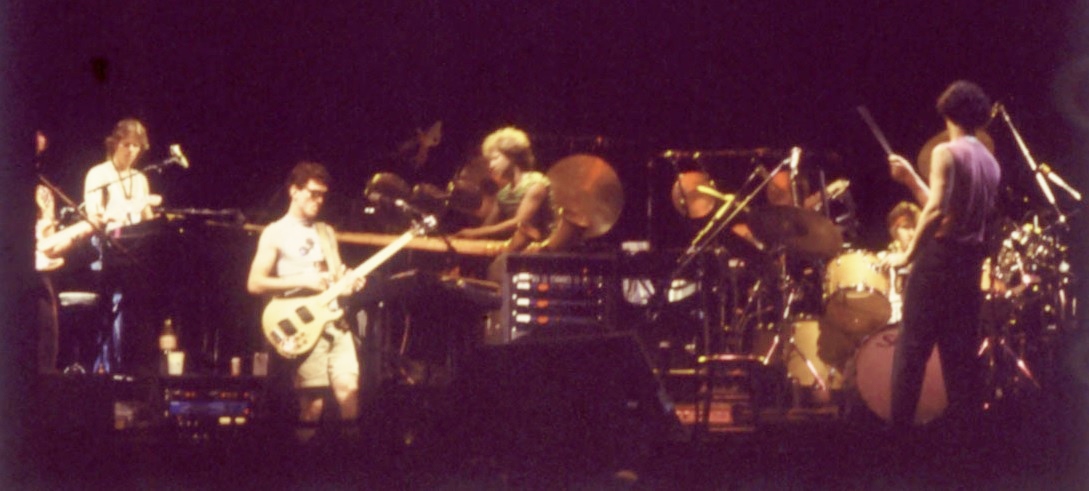 Whereas "Stick together" is one of the rare Zappa songs you might call musically dull,
"Moggio" belongs to his best work. It's an energetic piece with changing meters and a multitude of themes and variations.
Harmonically the melody keeps fluctuating between tonal and atonal.
Whereas "Stick together" is one of the rare Zappa songs you might call musically dull,
"Moggio" belongs to his best work. It's an energetic piece with changing meters and a multitude of themes and variations.
Harmonically the melody keeps fluctuating between tonal and atonal.
Moggio, 0:58-1:32 (midi file)
Moggio, 0:58-1:32 (transcription).
The main theme is in E minor
(bars 1-2 of the transcription). In the other bars some remnants of scales can be detected, or it's atonal altogether.
During most of the song the bass is playing a counterpoint line.
From bar 3 to bar 12 there's a longer period with varying meters, where I chose the relatively longer sustained notes as the opening notes
of the different meters. I can't guarantee that Zappa notated this exactly the same; there some alternatives possible just
as well. Bars 13 through 16 form a set of variations. All last 12/8 and contain a string of notes leading to
a longer sustained note. Bars 13 and 14 partially overlap; bars 14 and 16 are the same for their descant, though not entirely
identical as it comes to the bass line. The bass figures in bars 14-16 are variations upon each other.
In bar 17 a large string of 16th notes starts with an ongoing bass counterpoint melody. Stylistically this section is
comparable to the "Rollo interior" composition from "Apostrophe (')" (see that section for more about "Rollo interior").
Above to the right: Zappa conducting his band, around 1982.

"Moggio" knows a short introduction of four bars before the main theme starts.
Shown here is this intro as reproduced in the Zappa - The composer book by Daniel Schröder. It's deliberately irregular which each bar having its own meter.
The main theme starts in bar 5, here notated in 5/8 by Ali Askin.
Moggio, 0:00-0:09 (midi file).
Moggio, 0:00-0:09 (score/transcr.).
This opening is one of a number of examples from this study, where, when trying to transcribe it straight from the CD, it's very hard to impossible to figure out
how Zappa would have notated the meters. So this Ali Askin example makes this clear. His arrangement was used by the Ensemble Modern for their
"Greggery Peccary & other persuasions" CD from 2003. The liner notes briefly mention that Ali based his arrangement upon Zappa's lead sheet and listening to the versions
on "The man from Utopia" and "YCDTOSA vol. V". The example above follows the execution on "The man from Utopia". The first bar functions as a pick-up bar,
a snork followed by three pick-up notes.
The torture never stops (1980)
The "Buffalo" double CD with a 1980 concert offers an excellent version of "The torture never stops", lasting
over 23 minutes. It's included in this section
because it contains a block with Zappa doing another recitative. Moreover, this version includes two guitar solos
with keyboard solos and a drum solo in between them, all of them working out fine. The global construction goes as:
0:00 Instrumental opening of four bars beginning with the characteristic guitar-bass motif (A-E-A descending), followed by a chord
progression. All live versions do this as good as the same as the transcribed section from
"The torture never stops" in The best band
you never heard in your life section. These four bars get repeated four times.
0:27 Sung section. Here the bass keeps giving an A pedal note, instead of repeating the opening motif, as is normally done
during this song. Because Zappa keeps being loyal to the melody as it has been from "Zoot allures" onwards note for note,
the song is still very well recognizable.
1:20 The four-bar instrumental opening gets repeated twice.
1:33 Second sung section. Now Zappa does deviate from the original melody by singing the notes flat repeatedly, close to speaking
the words at some instances.
2:33 The four-bar instrumental opening gets repeated twice again.
2:47 A compositionally new block with Zappa doing a recitative. The opening is transcribed below.
The torture never stops (1980), 2:47-3:05 (midi file)
The torture never stops (1980), 2:47-3:05 (transcription).
a) After playing the bass lick one more time, the band has modulated from A Dorian to A for an instrumental intermezzo of
four bars.
b) In bar 5 of the transcription begins with an improvised recitative in a jazz manner with a fast walking bass
playing eighth notes. Everybody sings or plays chromatically, so as a composition it's all atonal. The same goes for
the above "The jazz discharge party hats".
c) End of this block with Zappa getting a bit melodic again with the line "he's the best of course of all the worst". The
band follows as probably pre-arranged, but quite different from "Zoot allures".
4:14 The band now continues with the lyrics "And it stinks so bad..." as on "Zoot allures", thus with the melody as
we know it.
4:38 The four-bar instrumental opening gets repeated four times.
5:05 First guitar solo in A Dorian.
a) First part with long sustained notes. Zappa is using the feedback of his guitar delicately to let the sound and volume
of the notes fluctuate. At one point (around 5:45) you've got a D sounding as a ship's horn.
b) Little theme of four bars with the chord progression III-II, played twice. The transcription below begins with
the repetition of these bars.
c) The solo continues as a normal A pedal solo, as from bar 5 onwards below.
The torture never stops (1980), 5:55-6:11 (midi file)
The torture never stops (1980), 5:55-6:11 (transcription).
10:48 Four keyboard solos. These solos are using the more normal way of doing solos in jazz bands, namely by playing over a chord
progression. The bass gives the root notes of these chords. Zappa himself would seldom play a solo that way (see the Guitar
section for more upon this topic). So stylistically they offer a good variation between the two solos by Zappa. Apart
from that Tommy Mars and Bob Harris are doing fine here.
14:34 Drum solo by Vinnie Colaiuta. Vinnie took over the traditional drum solo from Terry Bozzio. A separate one can be found
on "Halloween". No comment needed that Zappa had excellent drummers at his disposal. At the end you can hear the crowd
cheering probably because Zappa re-appears at the front of the stage. With the others doing longer solos he would often take
a pause at the back of the stage.
17:31 Second guitar solo in A Dorian.
21:34 The four-bar instrumental opening gets repeated four times again.
22:03 Third sung block.
23:22 Coda. All "The torture never stops" versions end with a similar coda. They are all variations upon
the one transcribed in the Zoot allures section.
23:36 End.
